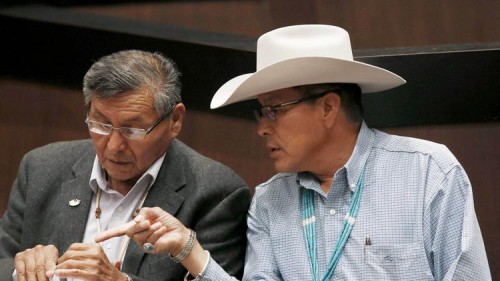By Jacob Batte, The Courier
HOUMA, La. (AP) – For local Indian tribes seeking federal recognition, congressional pushback is disappointing, but nothing new.
U.S. Rep. Rob Bishop, R-Utah, is demanding the Obama administration hold off on new rules that could make it easier for Indian groups to win federal recognition as tribes.
American Indians have been pushing for years to revise the process, but proposed regulations nearing the finish line have deeply divided existing tribes and Congress.
Bishop says he’s prepared to use every tool at his disposal to block enactment of the regulations. He criticized the Interior Department for forwarding the regulations to the Office of Management and Budget for final approval last week. He said the administration has ignored lawmakers’ requests to hold off on the rules until Congress has a chance to review them.
Albert Naquin, chief of the Isle de Jean Charles band of the Biloxi-Chitimacha-Choctaw, which includes about 600 members, said he’s saddened by the lengths some politicians have gone to hold tribes back.
Asked to comment on the efforts of people like Bishop, whom Naquin likened to anti-Indian President Andrew Jackson, he said he didn’t know how to answer the question, “but to get mad and express my real opinion.”
Federal recognition has been granted to 566 American tribes, and it is sought by others because of the health and education benefits it brings to tribal members, along with opportunities for commercial development.
Under the current recognition process, which dates back to 1978, the Interior Department has recognized 17 tribes and denied 34 requests, including the United Houma Nation in 1996 because, according to the government’s judgment, the tribe failed to prove it had an unbroken connection to the historic Houma tribe.
The Houma Nation, which boasts some 17,000 members, is recognized by the state but has tried since the 1970s to win federal recognition, which tribal leaders say could open the door to grants to address poverty and improve education.
The Lafourche and Terrebonne parish councils have expressed support for both tribes as well as the Pointe-au-Chien tribe.
The tribe isn’t looking for “a check in everyone’s hands” but rather the chance for proper education, health care and a sense of solace knowing where they live won’t vanish into the sea, said Houma Nation Principal Chief Thomas Dardar.
Dardar said the tribe is looking for around 300 acres of land, but 10 acres at the start of the process. Federal recognition would aid in that goal, he said.
The fight for recognition is expensive to the tribes, Naquin said. His tribe has spent money it doesn’t have to research put together the proposal.
A proposed rule issued 11 months ago changes some of the thresholds groups would need to meet to be federally recognized as a tribe. For example, the proposed regulation reduced how far back in time a tribe must demonstrate it has been a distinct political entity with authority over its members.
The National Congress of American Indians, whose members include leaders from dozens of tribes, is supporting the administration’s efforts.
Republicans and Democrats in Congress have expressed concern about the cost to the federal government and how approval of new tribes could alter the casino landscape in their home states.
“They think it’s about casinos, which have benefited a lot of tribes in a lot of ways. Not every tribe has casinos,” Dardar said. “That’s not even on our radar. … We’re worried about land loss and becoming more resilient.”
Existing tribes have also raised the casino issue and say that adding tribes would stretch already scarce federal resources allocated for health care, education and housing for Native Americans.
Dardar does share Bishop’s concern over easing the process of obtaining federal recognition. While there’s too much red tape now, he said, it shouldn’t be so easy that “anyone can come along and say we’re a tribe.”
Local tribes are optimistic their fight for federal recognition will soon prove fruitful.
Naquin said his tribe has employed someone to write up its proposal for federal recognition, and he believes it meets all the criteria. Now, he said, it’s a matter of putting it all together in the formal application.
“We did our research and we’ve got it done,” Naquin said. “We’re doing everything we can so they can’t come back and deny us.”







